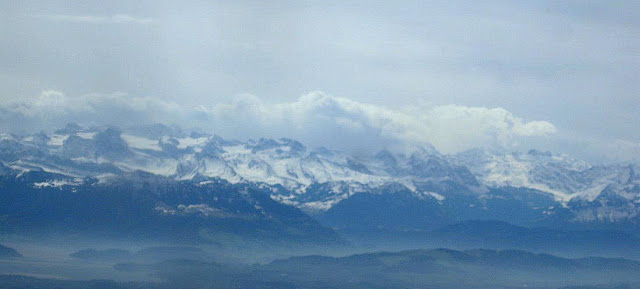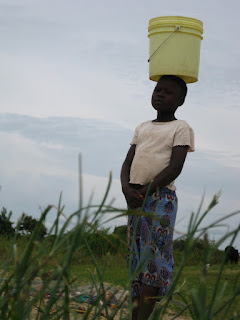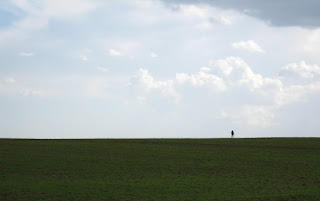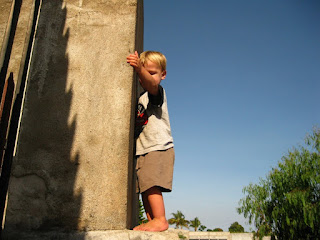I tagged along on yet another of Aram and Debbi's trips: this time to Tanzania.
The purpose of the trip was to visit various Mennonite establishments in Tanzania. Our destinations were Shirati- the first Mennonite mission post in East Africa- Musoma, and Mwanza.
The first day we drove about four hours and spent the night with some people who have an orphanage. They found one of their kids at the bottom of a pile of dirty laundry, several have showed up on their doorstep, and many have been given into their care by the family members of an abusive parent. They currently have twenty-five kids; the oldest is 15 and the youngest was three days old at the time of our visit. Most of the kids are under five.
On day two we drove four hours and spent two hours at the border. The first part of the two hours at the border were greatly enjoyed by Priska and Shadrach; some random truckers let them hang out in the cab of their truck...
The Tanzanian visas were twice as expensive as was expected, so we did not have enough dollars to pay for the visas and customs would not take Kenya shillings. And there was no place to change money at the border. Aram eventually had to cross back into Kenya to buy dollars.
After what seemed like an eternity, with two kids becoming more tired and manic by the minute, we were finally on our way.
Tanzania is quite different from Kenya; for one thing, there are actually road signs, and people obey the traffic laws. Also, the landscape differs greatly from just across the border; on the Kenya side it is semi arid and mostly flat, in Tanzania it is green, and all around are large, steep hills, strewn with enormous, granite boulders.
Six queries for directions later we arrived in Shirati, which is just a few kilometers from Lake Victoria.
We spent two days there visiting the church leaders and whatnot.
Shirati is a relatively small village, but there is a large hospital and medical college that the Mennonites started in the 1930s.
We went down to the beach one evening and Priska and Shadrach played in the sand for awhile. Much to my dismay, it is not advisable to swim because of the presence of
bilharzia in the water.
We were the main entertainment of the evening for the local kids, Priska and Shadrach especially.
This girl stood and watched us for half an hour, the whole time holding this five-gallon bucket of water on her head.
There were many egrets eating stuff at the water's edge.
And sitting on rocks...
A fishing boat
Next we drove three hours to Musoma, the location of a sizable bible college, also established by the Mennonites.
While Aram talked with the teachers and sat in on classes, I climbed one of the many hills in the area; I succeeded in getting some very nice panoramas but my panorama stitching program has ceased to function, so I will post them later.
A somewhat distorted view of the lake.
While in Musoma we stayed at a Catholic guest house that is right on the lake. We found out that the bilharzia parasites can be killed with a cheap, effective medicine, so we went swimming.
The kids really liked playing in the water and sand, and would do so happily for hours.
Shadrach's favorite activity was throwing handfuls of sand in the water.
Reloading....
Fishing dhows went out around sunset.
The waves gave me the opportunity to take some pictures that are pretty sweet and were rather dangerous to the life of my camera.
In Mwanza we just hung out with A&D's friends for two days. They have two kids almost the same ages as Priska and Shadrach, so the kids were really happy and crazy.
I read a bunch of random books: The Silmarillion, Origin of the Species, some stuff by Netzsche, a couple of papers on the the Sukuma Medicine Men and their magic stuff, et al. It was quite interesting...
On Sunday morning I decided to climb a boulder laden hill instead of going to a church service that I would understand none of. I saw all manner of amazing wild life: awesome birds...North America really got a bad deal when it comes to birds...Either that or we killed them all...
enormous butterflies
a troup of Vervet monkeys,
and brilliantly colored lizards that change color according to the temperature,
I spent over an hour trying to get a good picture of the crazy lizards, but they are really sensitive to nearby movement and move incredibly fast. And having only a 4x zoom does not help...
The females were not nearly as spectacular...
We took the bus back to Musoma, and while we were waiting at the bus stop, this guy without a shirt, wearing a motorcycle helmet and carrying an eighteen inch, evil looking knife starts walking around making motions as though he is chopping things into pieces. He stood directly behind me for a couple of minutes, slicing up invisible things...And that was somewhat disturbing...
Then he jammed the knife in his pants and started wandering around dancing. He continued this until another guy walked up behind him and tried to pull the knife out of his pants; unfortunately the serrations on the back of the knife got stuck on his pants. They struggled a bit and the protagonist got the crazy guy on the ground and confiscated the knife. By this time quite a crowd had gathered, but no one tried to help the guy get the knife or anything, they just watched...
The rest of the trip was uneventful, except at the border they gave us all manner of trouble...
I took 1223 pictures...Below are a few of the more interesting ones.
A flower of unknown species.
Guess.
Debbi and Priska in a fishing boat.
Sunset on Lake Victoria
The Lake reflected in some broken glass atop a wall.
In Maasailand (The black smudge is a person)
The Lake
Shadrach likes bananas
The main tourist attraction of Mwanza
Some fishermen. They spent about two hours pulling their net into an ever-small enclosure, and caught a grand total of seven fish...


































































